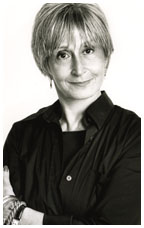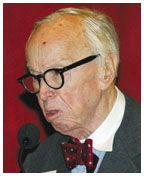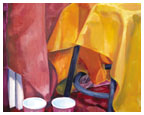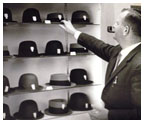November 17, 2004: Notebook
Former Duke president, professor to join faculty
Nannerl Keohane, left, and her husband, Robert O. Keohane will join the Woodrow Wilson School faculty next year. (Anthony Cross/The (Duke) Chronicle) |
Former Duke president, professor to join faculty
Nannerl Keohane, former president of Duke University, and her husband, political scientist Robert O. Keohane, will join Princeton’s faculty next fall at the Woodrow Wilson School of Public and International Affairs.
The Keohanes, who have been teaching at Stanford University’s Center for Advanced Study in the Behavioral Sciences since leaving Duke last summer, are the latest recruiting coups for the Wilson School, which within the last few years has also added Thomas Christensen, a Chinese foreign-policy expert; John Ikenberry, an international relations scholar; Helen Milner, a political economist; and Jennifer Widner, a specialist in comparative law and politics.
Nan Keohane, who will become the Laurance S. Rockefeller Distinguished Visiting Professor of Public Affairs and the Center for Human Values, served for a decade as Duke’s president. One of the first women to head a major research university, she previously served as president of Wellesley College, her alma mater, and taught at Swarthmore, the University of Pennsylvania, and Stanford. Having written extensively on political philosophy, feminism, and education, she currently is compiling a book of the speeches and writings she prepared while Duke’s president. Anne-Marie Slaughter ’80, dean of the Wilson School, noted that Keohane’s work brings together “serious academic work with ... applied philosophy and applied ethics.”
Robert Keohane, the James B. Duke Professor of Political Science at Duke, will become a professor of international affairs at Princeton. He is a past recipient of the Grawemeyer Award for Ideas Improving World Order and a former member of the faculty at Swarthmore, Stanford, Brandeis, and Harvard. Unlike most members of the Wilson School, who are also on the faculty of other departments within the University, Keohane’s appointment is only to the Wilson School, which he says will enable him to focus exclusively on matters of public policy.
Slaughter was enthusiastic about the new additions. “Nan Keohane brings a unique combination of training and a distinguished record in political theory and feminist theory,” she said in a statement. She described Robert Keohane, author of the award-winning After Hegemony: Cooperation and Discord in the World Political Economy (1984), as the “leading international relations scholar of his generation,” and said that he has “trained virtually every top international relations midcareer scholar currently working across the country, with a particular focus on mentoring women.”
Although the Keohanes were actively sought by Harvard, Yale, and other institutions, Princeton, Robert Keohane suggests, had personal ties that gave it an advantage. “Dean Slaughter is a wonderful recruiter,” he says. “We were at Harvard together. Her husband [Princeton politics professor Andrew Moravcsik] is a former student of mine. I was at their wedding.”
Both appointments require approval by the University Board of Trustees.
![]()
By M.B.

(Photo courtesy Touchstone Pictures by Ron Phillips) |
Filming was under way Oct. 25 at Blair Arch of “Annapolis,”
described as a “coming-of-age story” that takes place at the
U.S. Naval Academy (but was filmed largely at Philadelphia’s Girard
College). In Princeton, the movie’s crew transformed the arch into
a memorial wall. The Disney/Touchstone Pictures film stars James Franco,
Tyrese Gibson, and Jordana Brewster, and will be released in 2005.
![]()

Advanced dance students, from left, Kristen Arnold ’06, Jessica Baylan ’08, Marisa Swenson ’06, Natasha Kalimada ’07, Lara Ionescu ’06, and Laura Fitzpatrick ’08 practice “32 Variations in C Minor,” a James Waring dance choreographed for Beethoven's work of the same name. The students will perform at Princeton's dance festival in February, 2005. (courtesy MIT)
Twyla Tharp (Richard Avedon/courtesy Twyla Tharp) |
When award-winning choreographer Twyla Tharp spoke on campus Oct. 15, she delved into the roots of creativity, drawing examples from the lives of Mozart and Rembrandt. But by the end of her lecture, she returned to dance, the medium that has made her famous, and its creative role.
“Movement is the first thing we do,” Tharp, the Belknap Visitor in the Humanities, told a full house at the James Stewart Film Theater. “Movement is what generates music. Movement is what generates painting. Movement is basic to all our enterprises.”
The message resonated with students in the University’s dance program, many of whom spent the early afternoon discussing their craft with Tharp. In a departure from the survey style of the dance curriculum, students spent the semester’s first six weeks studying Tharp’s work. The knowledge and curiosity they compiled fed a vigorous and candid exchange. “When she challenged them, they challenged her back,” says Ze’eva Cohen, a professor of humanities and the head of dance studies. “She really met them eye to eye.”
Cohen has been part of the University’s dance program since its inception during the early days of co-education. She says it’s an exciting time for dance at Princeton. About 60 students are taking dance classes this semester, and six seniors are pursuing a certificate in dance. In recent years, Cohen has recognized a higher level of training among incoming students. A new performance venue at the Berlind Theatre, an expansion of the program’s guest choreographer program, and the addition of full-time lecturer and choreographer Rebecca Lazier also have bolstered the program.
While many dance students are novices, a handful of graduates have pursued careers as professional choreographers and performers. Certificate students have the chance to complete a
creative thesis, in addition to the thesis in their major, and this year two are pursuing that option. “I’m continually impressed, not only with their enthusiasm, but with their dedication to fit dance into every part of the schedule that they possibly can,” says Lazier, a Juilliard graduate who began teaching at Princeton in 2003.
Growing interest in the dance program has advantages and drawbacks.
While instructors have been able to make finer distinctions when grouping
dancers by ability, more students can mean fewer chances for individual
instruction. Courses include one choreography session per week and two
days of technical work. “I think our intellectual dance community
is very rich,” says certificate student Mariah Steele ’06.
“But if I had my way, I’d be taking more technical dance classes
during the week.” To help advanced students refine technique, the
program offers daily non-credit ballet classes, and extracurricular performing
groups provide other creative outlets. ![]()
By B.T.

(Photo: Beverly Schaefer) |
“The events on September 11 deepened Bush’s relationship with his creator and caused his faith-based presidency to embrace black or white thinking. Either you were for or against terrorism.”
Author and historian Arthur M. Schlesinger Jr. at an Oct. 22 conference
on the role of religion in public life. The conference was co-sponsored
by the James Madison Program in American Ideals and Institutions.
![]()

(Photograph by Frank Wojciechowski) |
The Program in Visual Arts is hosting an exhibition of new student paintings, including the still life, shown above, by Phoebe Springstubb ’07. The exhibition runs through Nov. 19 at the Lucas Gallery, 185 Nassau St. The gallery is open weekdays from 10 a.m. to 5 p.m. Admission is free.
Carl Bildt, the former prime minister of Sweden, will deliver the inaugural Prince of Liechtenstein lecture on self-determination and the international system at 7:30 p.m. on Thursday, Nov. 18, in Dodds Auditorium in Robertson Hall. Bildt, who as prime minister from 1991 to 1994 led Sweden into the European Union, also served as the UN Secretary General’s special envoy to the Balkans from 1999 to 2001. His lecture, which is sponsored by the Liechtenstein Institute on Self-Determination, will be simulcast to Bowl 2 of Robertson Hall.
Perry Cook, an associate professor in the department of computer science, will discuss “Technology and the Singing Voice” in a colloquium sponsored by the Department of Mechanical and Aerospace Engineering, on Friday, Nov. 19, from 2:30 to 3:30 p.m. in Room 222 of Bowen Hall at the Princeton Materials Institute. Admission is free.
On Monday, Nov. 22, the Program in
Science, Technology, and Environmental Policy’s Lunchtime Seminar
Series will feature Peter Singer, the Ira W. DeCamp
Professor of Bioethics in the University Center for Human Values. Singer’s
talk, titled “Producing Food: Some Ethical Questions and Food Production,”
will run from noon until 1 p.m. in 300 Wallace Hall. The series is free
and open to the public. ![]()

The University’s endowment produced a 16.8 percent return on investments in the fiscal year that ended June 30, outpacing the returns of the last three years combined and lifting the endowment’s value to $9.9 billion, according to Andrew Golden, president of the Princeton University Investment Company (Princo).
In a strong year for the stock markets, both domestic and international, the endowment produced significant gains in all asset categories except fixed income. Princo’s real-asset portfolio, which includes real estate and investments in resources such as oil and natural gas, generated a 17.8 percent return. Investments in developed markets boasted a 37.8 percent gain, 5 percent higher than the index.
“Our real success was not getting in the way of the market,” Golden said. “In years past, we have been successful in finding out ways to make money when most others weren’t. This year was more about the fact that our long-term plan allows us to make money in lots of different ways.”
Harvard and Yale, which have the nation’s two largest university endowments, reported returns of 21.1 percent and 19.4 percent in 2004, and Golden expects to see most schools showing double-digit gains, thanks to the market conditions.
In the coming year, Golden said he does not expect significant changes in the way Princo deploys its assets, but the investment group plans to devote more energy to expanding its knowledge of international markets.
Princeton has the largest endowment per student among undergraduate
institutions, as well as the greatest alumni support per student, according
to the Chronicle of Higher Education. The endowment funded 37
percent of the University’s operating budget in 2003—04. ![]()
By B.T.

Stormy Future
This year’s hurricane season has been devastating, but according to Thomas Knutson of Princeton’s Geophysical Fluid Dynamics Laboratory, worse weather may be on the horizon. Changing climate factors in the next 80 years, he says, could make hurricanes stronger. In the Sept. 15 issue of the Journal of Climate, Knutson and colleague Robert Tuleya of Old Dominion University published a study of 1,300 simulated hurricanes, using conditions of higher temperatures and carbon-dioxide levels, like those potentially caused by global warming. The result was a 6-percent increase in maximum surface-wind speed, and an 18-percent increase in average precipitation in areas within 60 miles of the storm center. If the number of hurricanes remains consistent, Knutson writes, “greenhouse gas-induced warming may lead to a gradually increasing risk in the occurrence of highly destructive category-5 storms.”
Staying in school
Minority students are more likely to complete their studies if they attend
selective rather than nonselective colleges, says sociology professor
Marta Tienda. In a paper presented with co-author Sigal Alon of Tel-Aviv
University at August’s annual meeting of the American Sociological
Association, the authors examined data from 38,000 college students collected
in three nonconsecutive years. The study found that all students who attend
selective schools have a greater chance of graduating, but the advantage
is even more significant for black and Hispanic students. “Strong
mentoring programs and more lucrative financial-aid packages” contribute
to the higher graduation rates, the authors write.
![]()

Hats may no longer be an essential part of the well-dressed student’s wardrobe, as they were in the 1950s, but the U-Store still offers a wide range of Princeton and general apparel. (university store archives) |
The Princeton University Store, home to everything from textbooks to T-shirts and (lately) turkey sandwiches, marks the beginning of its 100th year this fall.
Though a Princeton institution, the only constant in the U-Store’s long history has been change: in its stock, its floor plan, and even its location — all to keep pace with the fickle tastes of its customers. The range of Princeton apparel and souvenirs has increased enormously over the last decade; in addition to the traditional sweatshirts and ties, the store now sells bathing suits and mouse pads. The book department, which had been moved from the first floor to the third floor a few years ago to make more room for school supplies and dorm furnishings, was returned to its more prominent former location last summer at the request of the faculty.
Warren Thaler ’84, who served as a student trustee of the U-Store as an undergraduate and is a former chairman of the store’s board of directors, emphasizes the advantages of local ownership. “Everyone likes to beat up on the U-Store, but it’s still really a general store,” he says. “That means we, the University community, control it.”
Unlike bookstores at Yale, Harvard, the University of Pennsylvania, and many other colleges, the U-Store has beaten back attempts to become part of a national chain. The store was approached by Barnes & Noble several years ago, Thaler says, but when board members began to examine the chain’s proposal, they concluded that it would require them to cede too much control over the store’s operations, from hours to inventory. Instead, the U-Store remains a private cooperative, with more than 65,000 members who pay a $25 lifetime dues fee. More than half of the store’s current directors are students.
Recently, the U-Store branched into the convenience-store business by opening U-2, a rival to Wawa, which is open around the clock when classes are in session. In addition to soda, sandwiches, and chips, U-2 has begun carrying prepared foods from local restaurants, enabling University employees to pick up an order of General Tso’s chicken from Tiger Noodles on their way home or harried undergraduates to grab a pizza from Moondoggie Café while pulling an all-nighter.
The U-Store was founded in 1905 as an extension of a student-run bookstore that began in 1896. One of the changes brought by the store’s first professional manager, Robert C. McNamara 1903, was to add a line of athletic supplies. For more than half a century, the U-Store was located in West College but space remained a problem, so much so that by the 1920s, the store’s music stock had to be moved to a separate store on Nassau Street.
In 1958, the U-Store moved to its present location — its $500,000
headquarters designed by Eldredge Snyder ’22, who saw the building,
as PAW put it at the time, as “a contemporary statement of Gothic
feeling without a slavish following of Gothic forms.” Even so, it
outgrew its floor space and in 1972 took over the mezzanine, which had
housed the Daily Princetonian. In 1989, an entire third floor was added
to the building, and a branch was later opened in the new Frist Campus
Center. U-Store sales have grown, as well, from $60,000 per year in 1908
to approximately $9.5 million last year. ![]()
By M.B.

Although Princeton has been ranked atop the annual U.S. News & World Report survey for several years, a new study by a group of economists places the University sixth, behind Harvard, Yale, Stanford, Cal Tech, and MIT. The study, submitted to the National Bureau of Economic Research, analyzed the college choices of 3,200 high school students from the class of 2000. By asking which college they chose among the colleges that accepted them, the analysts compiled a “win-loss” record for each college, and from this data ranked the top 100 colleges in the country.
Among other Ivy League institutions, Brown ranked seventh, Columbia eighth, Dartmouth 10th, Penn 12th, and Cornell 15th. According to the study, a student admitted to both Harvard and Princeton would be three times more likely to matriculate in Cambridge. Predictably, the new ranking system was no less controversial than any other. “If one were a lemming, this would be a great way of picking a college,” Burke Rogers, college counselor at St. George’s School in Newport, R.I., told the New York Times.
Alan Hollinghurst,
an Old Dominion fellow and lecturer in the Council of the Humanities and
Creative Writing, has been awarded the 2004 Man Booker Prize, Great Britain’s
highest fiction award. Hollinghurst, who is teaching courses in introductory
and advanced fiction at Princeton this semester, earned the award for
his fourth novel, The Line of Beauty.
![]()








